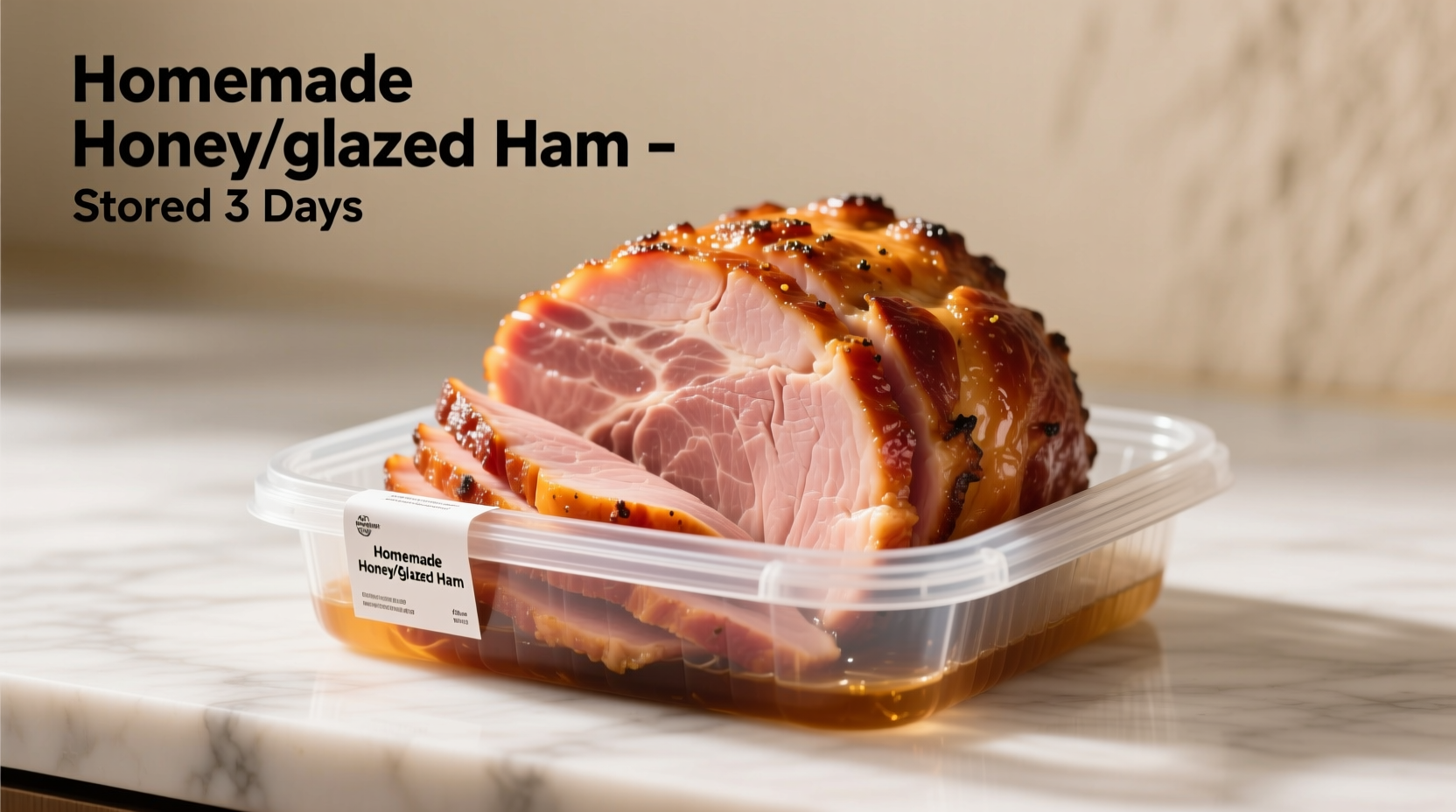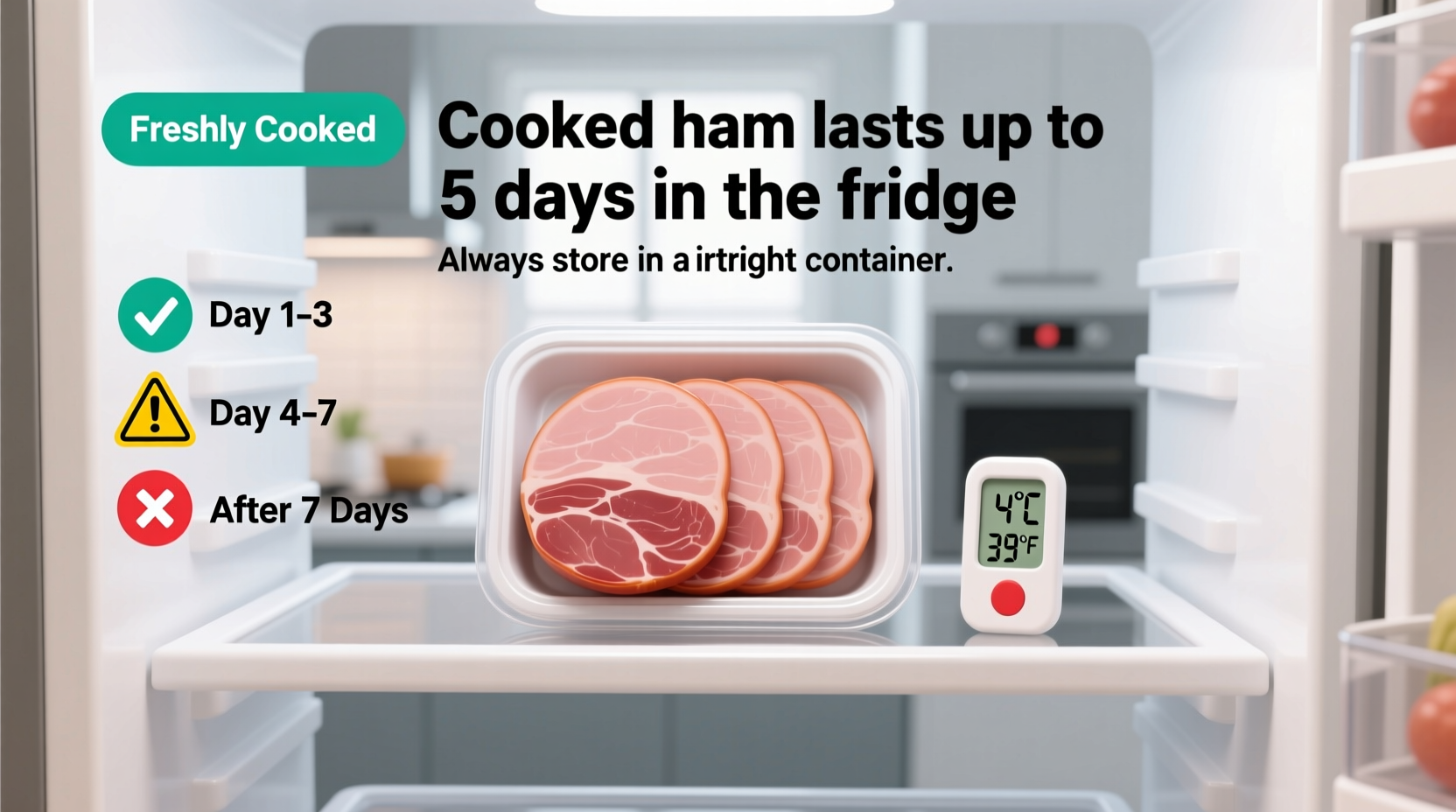Direct Answer: Properly stored cooked ham lasts 3-4 days in the refrigerator at 40°F (4°C) or below. Spiral-cut hams and leftovers from consumer-cooked hams maintain peak quality and safety for this timeframe when stored in airtight containers or wrapped securely.
Your Complete Guide to Cooked Ham Refrigeration Safety
Nothing ruins a celebration like foodborne illness from improperly stored ham. Whether you're dealing with holiday leftovers or meal-prepped slices, understanding exactly how long cooked ham lasts in the refrigerator prevents waste and protects your family's health. This guide delivers science-backed storage guidelines you can trust.
Why Refrigeration Time Matters for Cooked Ham
Cooked ham provides ideal conditions for bacterial growth - moisture-rich, protein-packed, and neutral pH. The USDA Food Safety and Inspection Service confirms that dangerous pathogens like Listeria and Staphylococcus can multiply rapidly between 40°F and 140°F. Proper refrigeration slows this growth, but doesn't stop it completely.
"Many consumers don't realize that 'fresh' doesn't mean 'forever safe,'" explains food safety expert Dr. Elizabeth Parker. "Cooked ham storage time follows strict food science principles - exceeding recommended windows dramatically increases illness risk."

Refrigeration Timeline: When to Eat or Toss
| Ham Type | Refrigerator Storage (40°F or below) | Freezer Storage |
|---|---|---|
| Whole cooked ham (store-wrapped) | 5-7 days | 1-2 months |
| Sliced/cubed cooked ham | 3-4 days | 1-2 months |
| Spiral-cut ham | 3-5 days | 1-2 months |
| Cooked ham leftovers | 3-4 days | 1-2 months |
Source: USDA Food Safety and Inspection Service (FSIS Guidelines)
Critical Storage Factors That Impact Shelf Life
These four elements determine whether your cooked ham stays safe for the full recommended period or spoils prematurely:
- Temperature consistency - Your refrigerator must maintain 40°F (4°C) or below. Use an appliance thermometer to verify.
- Initial cooling speed - Divide large portions into shallow containers to cool within 2 hours after cooking.
- Storage method - Vacuum sealing extends freshness better than plastic wrap. Glass containers with tight lids outperform plastic bags.
- Cross-contamination prevention - Store ham above raw meats to prevent drips. Use dedicated cutting boards.
Warning Signs Your Cooked Ham Has Spoiled
Don't rely solely on the calendar. Check for these critical spoilage indicators before consuming:
- Visual changes - Slimy film, unusual discoloration (green/gray spots), or mold growth
- Texture alterations - Excessive stickiness or sliminess when touched
- Odor development - Sour, ammonia-like, or rotten smell (fresh ham should have mild, pleasant aroma)
- Taste abnormalities - Sour or bitter flavor (only test if other signs are absent)
The USDA emphasizes: "When in doubt, throw it out." Consuming spoiled ham risks food poisoning with symptoms appearing 30 minutes to 3 weeks after ingestion.
Maximizing Freshness: Pro Storage Techniques
Follow these chef-tested methods to extend cooked ham's refrigerator life while maintaining quality:
- Immediate chilling - Place ham in refrigerator within 2 hours of cooking (1 hour if room temperature exceeds 90°F)
- Proper wrapping - Use moisture-proof materials: vacuum-sealed bags, aluminum foil with plastic wrap layer, or rigid containers
- Strategic placement - Store in coldest part of refrigerator (usually bottom shelf near back wall)
- Portion control - Divide into single-serving sizes to avoid repeated temperature fluctuations
Freezing Cooked Ham: When Refrigeration Isn't Enough
For longer storage, freezing cooked ham properly maintains safety indefinitely (though quality declines after 1-2 months). Follow these steps:
- Wrap tightly in freezer paper or heavy-duty aluminum foil
- Place in airtight freezer bags, removing as much air as possible
- Label with contents and freezing date
- Thaw safely in refrigerator (never at room temperature)
"Freezing stops bacterial growth completely," notes FDA food safety guidelines. "While texture may change slightly after thawing, frozen cooked ham remains safe indefinitely when stored at 0°F (-18°C) or below."
Special Considerations for Different Ham Types
Not all cooked ham follows identical storage rules. These variations affect how long cooked ham lasts in the refrigerator:
- Spiral-cut hams - Increased surface area accelerates spoilage. Consume within 3-5 days.
- Honey-glazed varieties - Sugar content may slightly extend freshness but requires careful monitoring for stickiness.
- Organic/nitrate-free options - Typically have shorter shelf lives due to absence of preservatives.
- Leftover holiday ham - Mixed with other ingredients (like pineapple or cloves) may spoil faster than plain ham.
Food Safety Risks of Ignoring Storage Guidelines
Consuming ham beyond safe storage windows risks serious illness. The CDC reports that foodborne pathogens in improperly stored meats cause approximately 9.4 million illnesses annually in the United States. Common consequences include:
- Staphylococcus aureus (onset: 30 min-8 hrs) - Nausea, vomiting, cramps
- Listeria monocytogenes (onset: 1-4 weeks) - Fever, muscle aches, meningitis
- Clostridium perfringens (onset: 6-24 hrs) - Diarrhea, abdominal cramps
Vulnerable populations - pregnant women, elderly individuals, and immunocompromised persons - face significantly higher risks of severe complications.
Practical Storage Solutions for Home Cooks
Implement these simple strategies to optimize cooked ham refrigerator storage without professional equipment:
- Use glass containers with locking lids for superior airtight protection
- Create a "ham-only" refrigerator zone to prevent cross-contamination
- Place a refrigerator thermometer near your ham storage area
- Label containers with "use-by" dates using masking tape
- Store ham below 40°F immediately after grocery shopping
"The difference between safe and risky ham often comes down to consistent temperature control," emphasizes Antonio Rodriguez, culinary expert. "Your refrigerator's door shelves fluctuate most - always store ham on interior shelves where temperatures remain stable."
When Leftovers Become Unsafe: Clear Disposal Guidelines
Follow these definitive rules for determining when to discard cooked ham:
- Exceeds 4 days in refrigerator (3 days for sliced/spiral-cut)
- Shows any visible mold (discard entire piece - don't just cut off moldy spots)
- Develops sour or unpleasant odor
- Feels slimy or sticky to touch
- Has been left at room temperature for over 2 hours
Proper disposal prevents accidental consumption. Double-bag spoiled ham and place in outdoor trash immediately.
Expert-Recommended Ham Storage Checklist
Before storing your next cooked ham, verify these critical safety points:
- Refrigerator temperature at or below 40°F (verified with thermometer)
- Ham cooled to room temperature within 2 hours of cooking
- Stored in airtight container or properly wrapped
- Separated from raw meats and ready-to-eat foods
- Labeled with storage date
- Placed on middle or lower shelf (not door)
Following this checklist ensures you're maximizing both safety and quality during your cooked ham refrigerator storage period.
Reheating Leftover Ham Safely
When using refrigerated ham, proper reheating destroys potential bacteria. Follow these guidelines:
- Reheat to internal temperature of 165°F (74°C)
- Use microwave, oven, or stovetop - avoid slow cookers for reheating
- Consume immediately after reheating
- Never reheat ham multiple times
The USDA Food Safety hotline confirms: "Proper reheating provides an additional safety barrier even when ham has been stored correctly."











 浙公网安备
33010002000092号
浙公网安备
33010002000092号 浙B2-20120091-4
浙B2-20120091-4